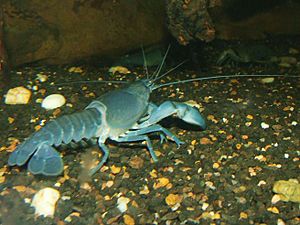Common yabby facts for kids
Quick facts for kids Common yabby |
|
|---|---|
 |
|
| Conservation status | |
| Scientific classification | |
| Kingdom: | |
| Phylum: | |
| Subphylum: | |
| Class: | |
| Order: | |
| Superfamily: | |
| Family: |
Parastacidae
|
| Genus: |
Cherax
|
| Species: |
C. destructor
|
| Binomial name | |
| Cherax destructor Clark, 1936
|
|
The common yabby (Cherax destructor) is a type of crayfish found in Australia. It lives in freshwater. Yabbies belong to a group of animals called crustaceans, which also includes crabs and prawns.
The name "yabby" is also used for many other Australian crayfish species. Yabbies can grow quite large, sometimes up to 30 cm (12 in) long. However, they are usually between 10–20 cm (4–8 in) in length.
Yabbies come in many different colours. Their colour depends on the water they live in and their surroundings. They can be black, dark brown, or even a light beige or green-brown. Some yabbies are specially bred to be a bright blue colour. These blue yabbies are popular as pets in aquariums in Australia.
Where Yabbies Live
Yabbies are very common in the Australian states of Victoria and New South Wales. You can also find them in southern Queensland, South Australia, and parts of the Northern Territory. This makes them the most widespread crayfish species in Australia.
They live in many different watery places. These include swamps, streams, rivers, large water storage areas (reservoirs), and farm dams. Yabbies prefer areas that are not too high up.
Yabbies can survive in places that dry up. They can stay alive for a long time, even several years, by going into a deep sleep. This sleep is called aestivation. They dig deep burrows into the muddy ground of dried-up creeks and swamps. They stay dormant there until the water returns.
What Yabbies Eat
Yabbies are mostly active at night. They are nocturnal. They mainly eat detritivores, which means they feed on dead plants and algae. But they will also eat any dead fish or animal remains they find.
In Southern Australia, yabbies are most active during the warmer months. When the water gets colder, below 16 °C (61 °F), they slow down. They enter a state of "partial hibernation." This means their bodies use less energy.
Yabbies are an important food source for many Australian freshwater fish. These include fish like Murray cod and golden perch.
Catching Yabbies
Catching yabbies, often called "yabbying," is a fun summer activity in Australia. It's especially popular with children. People go yabbying in rivers and farm dams.
One common way to catch them is simple. You tie a piece of meat to a long string or fishing line. Then, you tie the string to a stick on the bank and throw the meat into the water. When a yabby grabs the meat with its claws, the string will pull tight. You then slowly pull the line back to the bank. The yabby usually holds on to the meat. When the meat and yabby are close to the edge, you quickly scoop them up with a net.
Other ways to catch yabbies involve different types of nets and traps. However, it's very important to check the local fishing rules. Many types of nets and traps are not allowed. This is because other wildlife, like platypus, water rats, and long-necked turtles, can get caught in them and drown.
Yabbies as Food
People in Australia eat yabbies, much like people in other countries eat crayfish. They are not as common to eat as prawns, but they are still enjoyed.
Usually, yabbies are boiled and eaten plain. Sometimes, people add sauces or other seasonings. You might also find yabbies served in restaurants. There, they can be used in salads, ravioli, or pasta dishes.
In New South Wales, you can buy live yabbies at some fish markets, like the Sydney Fish Market. In Victoria, you can buy cooked yabbies that are ready to eat at the Queen Victoria Market.
Images for kids
-
Week-old yabby eggs, 2–3 mm, attached by tiny hairs to the underside of a female yabby. This picture is from CSIRO.



